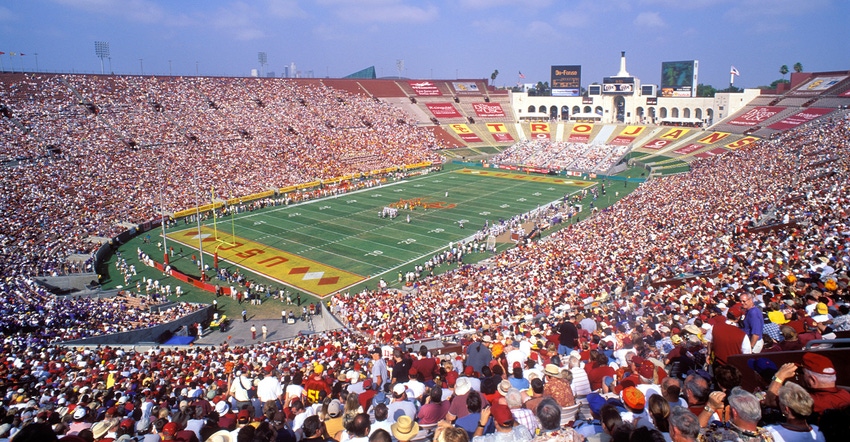USC Zero Waste Game Showcases Sustainability Importance
As part of the Pac-12's Zero Waste Competition, USC held its annual Zero Waste Game, showcasing the campus's commitment to sustainability. This specialty game encourages campuses to implement programs and practices that move events towards zero waste.

On September 9, the USC Trojans had no problem defeating Stanford in an interconference game at the Los Angeles Memorial Coliseum. While reining Heisman trophy winner Caleb Williams effortlessly accounted for four touchdowns in the first half, USC students were putting up their best effort against a more challenging foe - waste.
College football is enjoyed by millions of adoring fans every Saturday from late August through January, and some of these universities’ stadiums welcome more than 100,000 fans each week who are ready to cheer on their favorite teams in and out of the stadium. The unfortunate part is that not all these massive stadiums have bold sustainability plans, but the ones that do impact their area.
The Pac-12, the conference that USC belongs to currently hosts a competition between all of its schools to put on a “Zero Waste Game.” This specialty game encourages campuses to implement programs and practices that move events towards zero waste. This can be done directly through recycling, reuse, composting programs or working with partners to make impactful changes. Zero waste competitions use several critical factors in determining a winner, per se, including diversion. However, everyone wins when campuses can achieve a zero-waste distinction.
For USC, its game against Stanford was its zero-waste game for the year, which took a lot of preparation before any fans had even shown up for game day. Afterward, the game was called an absolute slaughter, but I digress. One of the significant changes to gamedays at the Memorial Coliseum is the implantation of reusable cups via a partnership with r.Cup, which is helping the stadium divert around 5,000 plastic cups a game away from landfills.
Another addition to the Memorial Coliseum is the initiative to collect all the plastic gloves used throughout concessions on gamedays. The gloves are collected and shipped to a facility, ensuring the added plastic is diverted from the landfill.
“The rest of [the programs] are just continuing on partnerships that we’ve already had and ensuring that it’s running as smoothly as possible while trying to reduce any waste in the stadium,” said Christopher Kalaw, sustainability assistant at the Los Angeles Memorial Coliseum.
The programs implemented for zero waste or “Green Games” at the Memorial Coliseum generally carry over year after year, with a few exceptions for special events. Sometimes USC’s mascot isn’t available to greet you at a tailgate and tell you to recycle, but the added signage and bins clearly indicate that you should be recycling that plastic bottle. But these programs highlighted for Green Games are put in place for the stadium well before each game.
For most schools that emphasize sustainability, student volunteers play a huge role in achieving goals and passing along helpful advice. New for USC is a class dedicated to sustainability that Kalaw had been working on. The course allows students to engage in sustainability efforts while learning about what it takes to put these initiatives in motion. Students can learn from a living laboratory by participating in Green Games and seeing what USC does to achieve zero waste.
Other schools nationwide have sustainability initiatives and programs to keep waste contributions as low as possible. While Zero Waste Games put on by the Pac-12 may be a competition, recycling should always be considered a collective effort. The more we can educate our neighbors, friends, fans, and rivals on recycling, the better we’ll all be at preserving our environment. The Memorial Coliseum and USC have a leading sustainability program and have passed that information on to other schools.
“The way I’ve seen it since I’ve been on the team is, a lot of schools come to our program and learn what we’re doing,” said Kalaw. “We educate other schools; we’ve been a leader in that space, but there’s always room to grow. So, we always hear of new programs and other things and try to figure out, ‘Is that something we need? How could this help us?’”
Kalaw mentioned that for USC and the Memorial Coliseum, two key components that make their sustainability efforts so successful are that they control what they procure and hand sorting.
“First, everything that we’re procuring is environmentally friendly, and we’ve partnered with concessionaries to make sure that’s possible,” said Kalaw. “The second step, which works in tandem with procurement, is that we do hand sorting for large events, and that really boosts our diversion numbers.”
Passionate campuses participating in zero waste competitions is an excellent way to move the sustainability needle in the right direction. If I know anything, any time students can hold bragging rights over a conference rival is an easy way to get them involved. The next step is to take those programs, manufacture sustainable events, and educate other students and attendees, slowly spreading recycling initiatives and diverting more waste.
About the Author(s)
You May Also Like




